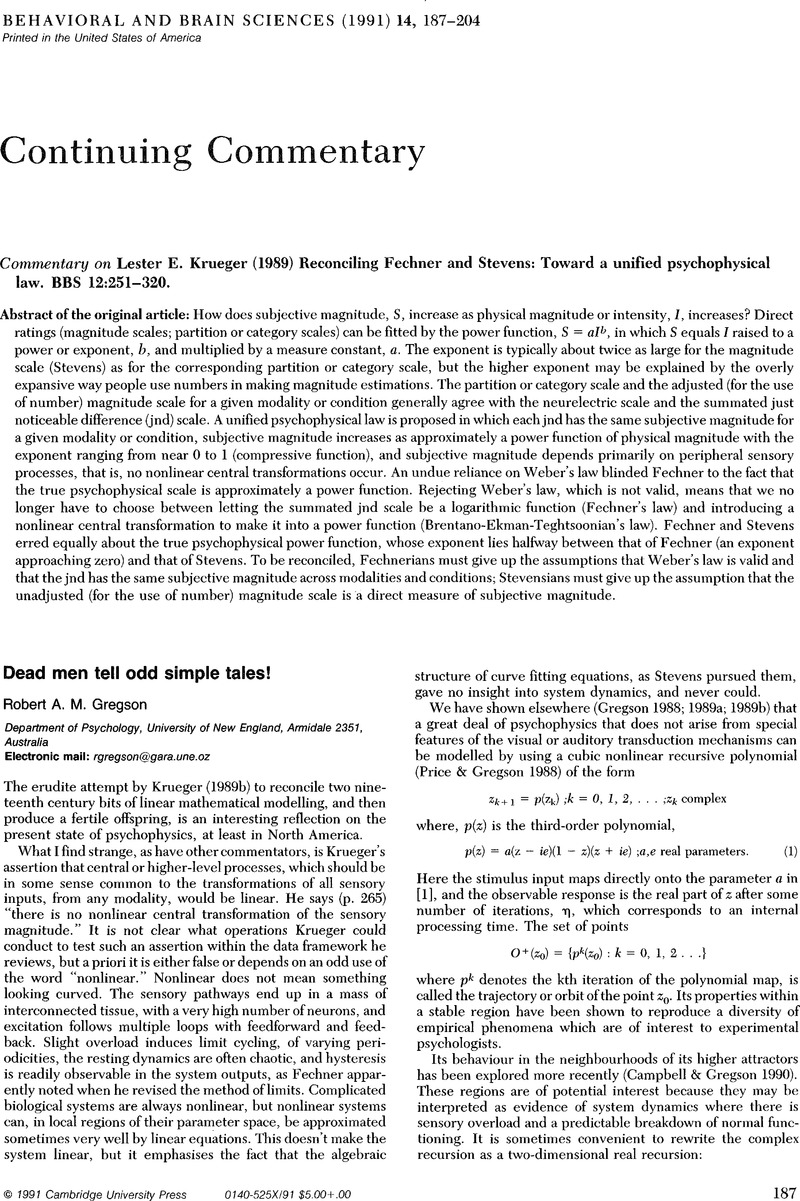Crossref Citations
This article has been cited by the following publications. This list is generated based on data provided by Crossref.
Laming, Donald
1993.
The antecedents of signal detection theory.
Behavioral and Brain Sciences,
Vol. 16,
Issue. 1,
p.
151.
Gregson, Robert A. M.
1993.
The head and tail of psychophysical algebra.
Behavioral and Brain Sciences,
Vol. 16,
Issue. 1,
p.
141.
Wagner, Mark
1993.
On the construction of psychophysical reality.
Behavioral and Brain Sciences,
Vol. 16,
Issue. 1,
p.
164.
Murray, David J.
1993.
A perspective for viewing the history of psychophysics.
Behavioral and Brain Sciences,
Vol. 16,
Issue. 1,
p.
115.
Petrusic, William M.
1993.
Response time based psychophysics: An added perspective.
Behavioral and Brain Sciences,
Vol. 16,
Issue. 1,
p.
158.
Lebedev, Artour N.
1993.
Derivation of Stevens's exponent from neurophysiological data.
Behavioral and Brain Sciences,
Vol. 16,
Issue. 1,
p.
152.
Krueger, Lester E.
1993.
History of psychophysics: Some unanswered questions.
Behavioral and Brain Sciences,
Vol. 16,
Issue. 1,
p.
149.
Lockhead, Gregory R.
1993.
A parallel view of the history of psychophysics.
Behavioral and Brain Sciences,
Vol. 16,
Issue. 1,
p.
154.
Hornstein, Gail A.
1993.
The chimera of psychological measurement.
Behavioral and Brain Sciences,
Vol. 16,
Issue. 1,
p.
148.
Whittle, Paul
1993.
A perspective for viewing the present of psychophysics.
Behavioral and Brain Sciences,
Vol. 16,
Issue. 1,
p.
165.
Teghtsoonian, Robert
1993.
Sensation strength: Another point of view.
Behavioral and Brain Sciences,
Vol. 16,
Issue. 1,
p.
161.
Grüsser, Otto-Joachim
1993.
The discovery of the psychophysical power law by Tobias Mayer in 1754 and the psychophysical hyperbolic law by Ewald Hering in 1874.
Behavioral and Brain Sciences,
Vol. 16,
Issue. 1,
p.
142.
Heidelberger, Michael
1993.
Fechner's impact for measurement theory.
Behavioral and Brain Sciences,
Vol. 16,
Issue. 1,
p.
146.
Treisman, Michel
1993.
Psychophysics and the mind-brain problem.
Behavioral and Brain Sciences,
Vol. 16,
Issue. 1,
p.
162.
Gigerenzer, Gerd
1993.
From metaphysics to psychophysics and statistics.
Behavioral and Brain Sciences,
Vol. 16,
Issue. 1,
p.
139.
Olsson, Mats
Harder, Kathleen
and
Baird, John C.
1993.
What Ekman really said.
Behavioral and Brain Sciences,
Vol. 16,
Issue. 1,
p.
157.
Murray, David J.
1993.
The place of psychophysics in the history of sensory science.
Behavioral and Brain Sciences,
Vol. 16,
Issue. 1,
p.
166.
Borg, Gunnar
1993.
A perspective on psychophysics is not derived just from the history of psychophysicists.
Behavioral and Brain Sciences,
Vol. 16,
Issue. 1,
p.
138.
Marks, Lawrence E.
1993.
Quantifying, valuing, choosing.
Behavioral and Brain Sciences,
Vol. 16,
Issue. 1,
p.
156.
Luce, R. Duncan
1993.
Let's not promulgate either Fechner's erroneous algorithm or his unidimensional approach.
Behavioral and Brain Sciences,
Vol. 16,
Issue. 1,
p.
155.



